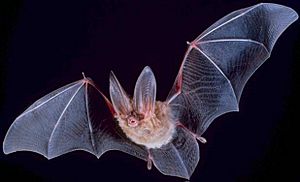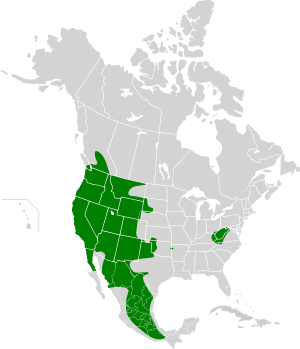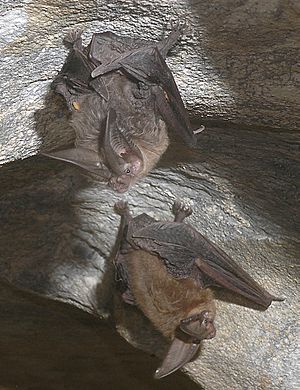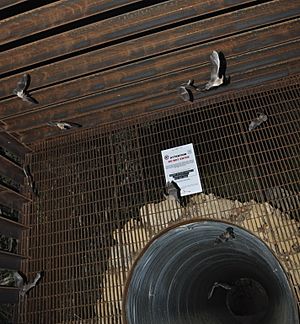Townsend's big-eared bat facts for kids
Quick facts for kids Townsend's big-eared bat |
|
|---|---|
 |
|
| Conservation status | |
| Scientific classification | |
| Genus: |
Corynorhinus
|
| Species: |
townsendii
|
| Subspecies | |
|
See text |
|
 |
|
| Synonyms | |
|
|
The Townsend's big-eared bat (Corynorhinus townsendii) is a special type of vesper bat. It's known for its super long ears!
Contents
What Does It Look Like?
This bat is a medium-sized animal. It usually weighs between 7 and 12 grams. That's about as much as a few paper clips! Its whole body is about 10 centimeters (4 inches) long, and its tail is around 5 centimeters (2 inches). When its wings are spread out, they can reach about 28 centimeters (11 inches) wide.
The most amazing part of this bat is its ears. They are super long and can bend in many ways. It also has two small bumps on its nose, which are easy to spot.
Where Do These Bats Live?
You can find Townsend's big-eared bats in Canada, Mexico, and the United States. They live in many different places across these countries.
Life Cycle and Habits
These bats have an interesting life cycle. They mate in the late fall. After mating, the female bat stores the male's sperm inside her body. The actual fertilization, when the egg and sperm join, happens in the spring.
Raising Young Bats
Once the egg is fertilized, the baby bat grows inside the mother for about 50 to 60 days. When a baby bat, called a pup, is born, it cannot fly yet. Female bats usually have only one pup at a time. These bats can live for a long time, with some living up to 16 years!
Where Do Bats Rest and Sleep?
Townsend's big-eared bats need big, open spaces to rest. They might choose abandoned buildings, old mines, natural caves, or even hollow parts of trees.
- Summer Homes: In the summer, these bats often live in rocky cracks, caves, and old buildings. Males usually live alone during this time. Females, however, gather together in large groups called maternity colonies. This is where they raise their pups. A maternity colony can have anywhere from 12 to 200 bats. In some parts of the eastern United States, these groups can be even bigger, with over 1,000 bats!
- Winter Sleep (Hibernation): When winter comes, these bats go into a deep sleep called hibernation. They often choose rocky cracks, caves, tunnels, old mineshafts, spaces under loose tree bark, or hollow trees. They like temperatures between 0°C and 11.5°C (32°F to 53°F). During hibernation, they huddle together in tight groups. This might help them stay warm. Males often hibernate in warmer spots than females. They also tend to wake up more often and move around or even switch caves during the winter. Before they hibernate, these bats eat a lot to gain weight. This extra fat helps them survive without food during their long winter sleep.
How They Find Food
These bats usually have two or three feeding times between sunset and sunrise. In between these feeding times, they take breaks and rest in different spots from where they sleep during the day. When flying in a straight line, these bats can reach speeds of about 2.9 to 5.5 meters per second (6.4 to 12.3 miles per hour).
What Do They Eat and How Do They Find It?
Townsend's big-eared bats love to eat moths! They are known as "moth specialists" because moths make up most of their diet. But they also eat other small insects like flies, lacewings, dung beetles, and sawflies.
Echolocation: Their Super Sense
These bats are called "whisper bats." This means they use echolocation (sending out sounds and listening for echoes) at very low sound levels. It can be hard to hear them with a special bat detector. They might do this because some moths can hear bats. These moths can even make their own noises to "jam" or confuse the bat's echolocation, trying to escape being caught.
How Their Body Helps Them Fly
Townsend's big-eared bats have a special body shape that helps them fly. They have "low wing loading," which means their wings are very large compared to their body weight. This design helps them:
- Get a lot of lift (go up easily).
- Be very good at turning and moving in the air.
- Fly slowly.
- Even hover in one spot!
Their huge ears, called pinnae, usually stay in line with their body when they fly. This shows that their ears also help them with lift during flight. Of course, their ears are also super important for hearing. They help the bat tell the difference between everyday sounds and the sounds of predators or prey.
Different Types of Townsend's Big-Eared Bats
There are five different types, or subspecies, of Townsend's big-eared bat:
- C. t. australis
- C. t. townsendii – This is the main Townsend's big-eared bat.
- C. t. ingens – Also known as the Ozark big-eared bat. This one is federally endangered, meaning it's at high risk of disappearing.
- C. t. pallescens – Called the western big-eared bat.
- C. t. virginianus – Known as the Virginia big-eared bat. This one is also federally endangered and is the state bat of Virginia.
See also
 In Spanish: Corynorhinus townsendii para niños
In Spanish: Corynorhinus townsendii para niños




